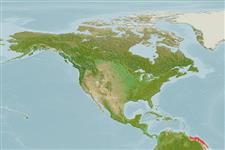Common names from other countries
Classification / Names / Names
ชื่อสามัญ | ชื่อพ้อง | Catalog of Fishes (gen., sp.) | ITIS | CoL | WoRMS
Environment: milieu / climate zone / depth range / distribution range
นิเวศวิทยา
; ระดับความลึก 100 - 298 m (Ref. 271). Tropical; 14°N - 1°N, 58°W - 47°W (Ref. 4)
Western Atlantic.
Length at first maturity / ขนาด / น้ำหนัก / Age
Maturity: Lm ? range ? - ? cm Max length : 10.0 cm TL เพศผู้/กระเทย; (Ref. 271)
It has lengths of 10 cm, maximum body length; 1.6 to 3.2 cm, carapace length (Ref. 4). Occurs at depths from 120 and 298 m, but there is a record from the littoral zone, and one from 4111 to 4122 m. The bottom is variously described as "sand and coral, "sandy calcarenite", and "smooth, consisting of brown mud" (Ref. 4).
Life cycle and mating behavior
วัยเจริญพันธุ์ | การสืบพันธุ์ | การวางไข่ | เซลสืบพันธ์ของเพศเมีย(ไข่) | ความดกของไข่ | ตัวอ่อน
Members of the order Decapoda are mostly gonochoric. Mating behavior: Precopulatory courtship ritual is common (through olfactory and tactile cues); usually indirect sperm transfer.
Holthuis, L.B. 1991. (Ref. 4)
IUCN Red List Status (Ref. 130435)
CITES status (Ref. 108899)
Not Evaluated
Not Evaluated
Human uses
การประมง: ไม่มีผลประโยชน์
| FishSource |
เครื่องมือ
ข้อมูลเพิ่มเติม
Age/Size
การเจริญเติบโต
Length-weight
Length-length
สัณฐานวิทยา
ตัวอ่อน
อุดมสมบรูณ์
แหล่งที่มาจากอินเตอร์เน็ต
Estimates based on models
Preferred temperature
(Ref.
115969): 13.6 - 18.8, mean 17.6 (based on 5 cells).
Vulnerability
Low vulnerability (10 of 100).
